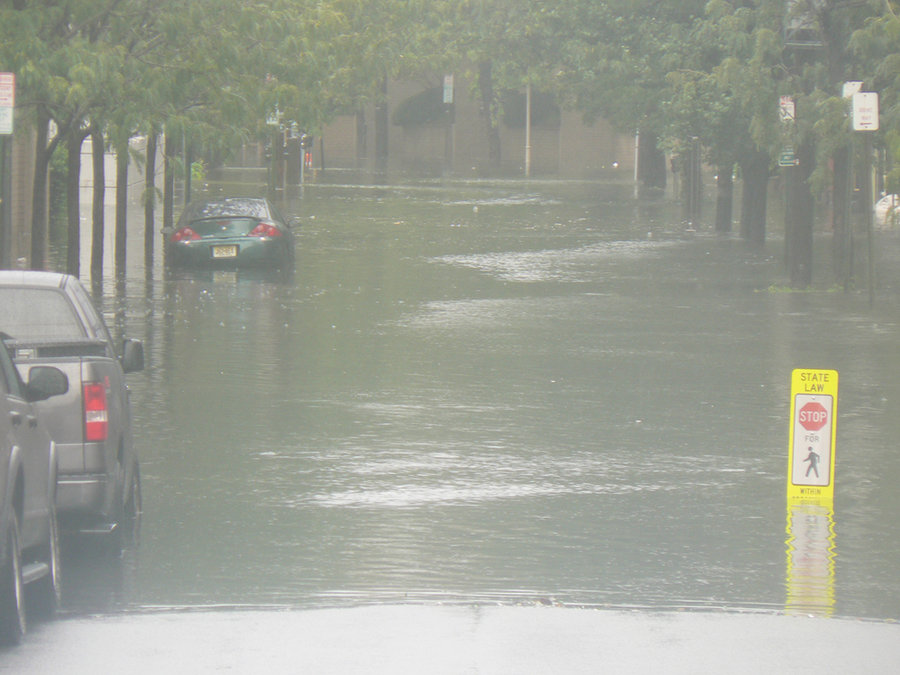Flooding has been a part of Hoboken’s identity seemingly since the low-lying city’s founding. When a new $18 million, long-awaited downtown pump opens around Oct. 17, severe flooding could be a problem of the past.
The pump is financed by the North Hudson Sewerage Authority, which deals with sewage and drainage in Hoboken and several other towns.
The southwest area of Hoboken tends to get the most flooding, especially during heavy rains and during the high tide of the Hudson River. The most recent major storm to hit Hoboken was Hurricane Irene, which, although not as bad as some predicted, buried blocks as far east as Garden Street.
“The pump is designed to push out 100 million gallons per day.” – Richard Wolff
____________
The city has an old “combined sewer system,” which means sewage and rainwater travel through the same pipes. The backup adds a foul stench to the western neighborhoods when flooding persists.
The new pump is underground near the downtown New Jersey Transit terminal at the city’s southern border, and is designed to counteract the effects of gravity and pressure from high tide and to push water out from the city’s sewer system and into the river after basic filtering to meet environmental standards.
“The pump is designed to push out 100 million gallons per day,” Wolff said. “Perhaps not in a hurricane, but in most severe rain events, the flooding will either be eliminated or minimized. I think that’s a reasonable expectation for residents to have.”
Wolff said his engineers at the NHSA believe that if another hurricane happens like Irene, the water will drain quicker, although some flooding is still likely.
The alleviation of flooding in downtown Hoboken will likely have an impact on flooding in the rest of the city.
“The system was built to be interconnected,” Wolff said. “So what should happen is that there is a pump pushing water out of the southwestern portion of the city, and now perhaps the flooding will be alleviated in other areas of the city as well…that’s how it should work, in theory.”
After the pump is operational, the NHSA will be in the process of evaluating how the pump alleviates flooding.
“If there’s any blockages citywide [in the sewers], we’ll address those to make sure we have the maximum effectiveness of that one pump,” he said.
The pump was financed by the NHSA to the tune of $13 million, and the Authority also received $5 million in grant money from the federal government’s American Recovery and Reinvestment Act.
While public officials in Hoboken originally discussed the possibility of multiple pumps in the city, the NHSA will simply be observing the progress of the southwestern pump.
The NHSA is also working to upgrade their uptown treatment plant.
“We’ll be in an evaluation mode, reviewing what the best next steps are depending on the broad impact of the pump on the rest of the city,” Wolff said.
Impact on real estate
Joseph Nichols of REALTY EXPRESS LaBarbera believes the new pump will not have an immediate impact on the real estate market in Hoboken.
“It might have a bigger effect on mortgage and insurance rates, but in terms of buyers I don’t think it’s going to make or break people buying in certain areas,” he said.
Nichols, a lifelong Hoboken resident, said until recently, he has not encountered flood-weary purchasers.
“Before Hurricane Irene, it wasn’t brought up too often that people might not want to buy on streets like Seventh and Monroe,” he said. “But flooding has always been an issue with first floor and basement apartments, no matter where it was in the city. Now after this hurricane, it seems the red flag has been raised.”
During the hurricane, Mayor Dawn Zimmer issued a mandatory evacuation for ground floor apartments, fearing more than five feet of flooding in the city.
Ray Smith may be reached at RSmith@hudsonreporter.com
SIDEBAR
Indiana Jones and the sewers of doom
Sewers in Hoboken were built during the same era as the Civil War. That’s why the North Hudson Sewerage Authority is in the process of renovating the sewers to bring them two centuries forward.
The sewers are so old that an archaeologist travels with the NHSA when they renovate the system.
The main danger of having old, wooden sewers is that the system may collapse, said Richard Wolff, the NHSA executive director. If a sewer system collapses, the roads also collapse, causing the need for large-scale, expensive and extensive repairs.
The updated sewers will still be wooden, but they become modernized through a “gun-iding” process, similar to how a pool is renovated. The NHSA has paid almost $40 million in sewer rehabilitation since 1998.
